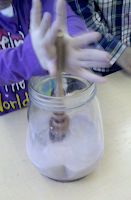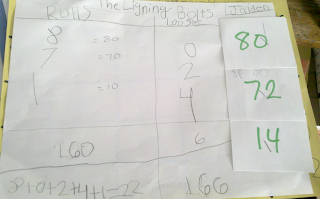In science, we are studying rocks! Right now we are learning the skills a geologist must have to categorize, sort, and observe rocks. We've been using hand-lenses, magnifiers, water, paper, and brushes to observe rocks and then group them.
Yesterday we planned our first rock hunt - we're going to be heading into the community next week in search of rocks! We chose places we think will have a variety of rocks and will be safe for us to visit.
All ready in our classroom, though, is a growing rock collection. Students have been finding rocks in the park, on their walk to school, and even here at EVCS and adding them to our collection. We use our scientific observation tools to look at them closely when we have a chance and record our thoughts and observations.
The rocks keep coming and our collection keeps growing! Stop by to check it out!
A blog about our year as Second Graders at The East Village Community School.
Tuesday, January 31, 2012
Wednesday, January 25, 2012
Bate, Bate, Chocolate!
Today in Spanish class, we made Mexican hot chocolate!
Last week we learned a song called "Bate, Bate, Chocolate" which means "Stir, Stir, Chocolate".
In Mexico, they use a molinillo to mix chocolate, hot milk, and spices. It is held between the palm of your hands and rotated back and forth.
To make the hot chocolate, we first got a hot pitcher of milk and a large piece of Mexican chocolate.
First, we had to break the chocolate into pieces.
Then, we put the pieces of chocolate into the hot milk.
Next, we used a molinillo to mix the chocolate and milk together. Our chocolate was already spiced so we didn't have to add anything else!
After mixing for a long time (we each had to count to 20 in Spanish before passing it to the next person), it was ready to drink. Yum!
Last week we learned a song called "Bate, Bate, Chocolate" which means "Stir, Stir, Chocolate".
In Mexico, they use a molinillo to mix chocolate, hot milk, and spices. It is held between the palm of your hands and rotated back and forth.
To make the hot chocolate, we first got a hot pitcher of milk and a large piece of Mexican chocolate.
First, we had to break the chocolate into pieces.
Then, we put the pieces of chocolate into the hot milk.
Next, we used a molinillo to mix the chocolate and milk together. Our chocolate was already spiced so we didn't have to add anything else!
After mixing for a long time (we each had to count to 20 in Spanish before passing it to the next person), it was ready to drink. Yum!
T-Shirts! Get your T-Shirts!
Today is our T-Shirt sale after school! We will be selling the remaining tie-dyed shirts we have for $5.00 in the school yard. We've sold half of them already to staff, students, and parents who have come in to inquire about our factories.
In our Math T-Shirt factory, we have made a divide. We've decided that having one big factory was just too much - so we split into 5 smaller factories. We are now...

The Lightning Bolt Factory
Rock and Roll Factory
Planet Shirt Factory
The Awesome T-Shirt Factory
Exterminator Factory
Our five factories got all of our inventory in the 4 sizes we carry, Small, Medium, Large, and X-Large. The problem was, I got sloppy when giving out the shirts and just piled shirts as I pulled them off of the shelves. I was not organized!
Before each factory could start advertising and selling their shirts, they had to figure out how many shirts of each size they now have! So, each factory worker had to add up the piles I made to figure out how many shirts they had in all. Here is the work the four factory workers from The Lightning Bolt Factory:
They determined that they have 189 Smalls, 90 Mediums, 166 Larges, and 162 X-Larges.
Next they had to figure out, as a group, how to store their shirts in their own warehouse. They saw how confusing it was when the shirts weren't organized, so they put shirts into boxes and rolls when they could.
A box holds 100 shirts - or 10 rolls. A roll holds 10 shirts. And of course, sometimes there are just loose shirts that can't be put into a full roll or box.
Here is the inventory for The Lightning Bolt Factory:
Today they will figure out what their ledger will be before they start selling. Each factory will be selling their shirts for $10 each. So how many shirts are there all together? How much are all of their shirts worth? Today we will answer these questions so that we're ready for the orders to start coming in!
In our Math T-Shirt factory, we have made a divide. We've decided that having one big factory was just too much - so we split into 5 smaller factories. We are now...

The Lightning Bolt Factory
Rock and Roll Factory
Planet Shirt Factory
The Awesome T-Shirt Factory
Exterminator Factory
Our five factories got all of our inventory in the 4 sizes we carry, Small, Medium, Large, and X-Large. The problem was, I got sloppy when giving out the shirts and just piled shirts as I pulled them off of the shelves. I was not organized!
Before each factory could start advertising and selling their shirts, they had to figure out how many shirts of each size they now have! So, each factory worker had to add up the piles I made to figure out how many shirts they had in all. Here is the work the four factory workers from The Lightning Bolt Factory:
They determined that they have 189 Smalls, 90 Mediums, 166 Larges, and 162 X-Larges.
Next they had to figure out, as a group, how to store their shirts in their own warehouse. They saw how confusing it was when the shirts weren't organized, so they put shirts into boxes and rolls when they could.
A box holds 100 shirts - or 10 rolls. A roll holds 10 shirts. And of course, sometimes there are just loose shirts that can't be put into a full roll or box.
Here is the inventory for The Lightning Bolt Factory:
Today they will figure out what their ledger will be before they start selling. Each factory will be selling their shirts for $10 each. So how many shirts are there all together? How much are all of their shirts worth? Today we will answer these questions so that we're ready for the orders to start coming in!
Wednesday, January 18, 2012
T-Shirt Factory!
Our T-Shirt Factory is open!
In math, we are studying place value, addition, and subtraction. To make it come alive, we've opened a T-shirt Factory! In our factory, shirts can either be stored as loose shirts, in rolls of 10, or in boxes of 10 rolls (100 shirts). Using these amounts, we can find equivalent numbers, add and subtract shirts, and break apart numbers.
First, orders started rolling in. If an order for 78 shirts came in, we had to ask ourselves, "How many rolls of shirts is this? How many loose shirts?" At first, we only looked for the most efficient way - 7 rolls and 8 loose shirts. Now are looking for all the possible ways to make this order:
Order for :: 78 shirts
 ROLLS | LOOSE SHIRTS
ROLLS | LOOSE SHIRTS0 | 78
1 | 68
2 | 58
3 | 48
4 | 38
5 | 28
6 | 18
7 | 8

Using this strategy, we see that 6 tens and 18 ones is equal to 2 tens and 58 ones or to 7 tens and 8 ones.
Today we will begin combining orders. How can we use this strategy of breaking apart numbers to easily add larger amounts? Today we will explore just that.
Of course, at EVCS we don't keep math just inside of the math workshop! We tie-dyed shirts last week during our Family Friday! We learned new art techniques and had a great time. On Wednesday, 1/25/12, we will be selling our remaining shirts in the yard after school. Now our factory feels quite real!
Thursday, January 5, 2012
Story Writing
A new year means a new writing unit, and we are completely switching gears! We are becoming story writers!
In Reading Workshop, we've learned the three main elements of a story: Characters, Setting, and Plot. We are identifying these three elements in our read-aloud books as well as our independent reading books.
Now we are becoming writers of stories!
Our first step in the writing process is drafting/planning. For this unit we are using a technique called Story Boards. Story Boards use pictures (and a few words) to help us plan our writing, gather details, and figure out the plot so that it makes sense.
We're using post-it notes so that we can move things around and make sure it's great before we start writing.
Next, we begin the drafting process. Looking at each post-it individually, we are really writing a lot more details! Some of us are writing scary stories, some sad stories, some happy stories, and even some funny stories - but they all are full of suspense. These stories will have you on the edge of your seat!
We'll be writing three stories during this unit -- some will be fiction, some non-fiction, and some a little of both (the names have been changed to protect the innocent sort of thing!) but they all will have our three main elements: Characters, Setting, and Plot.
We will pick one to publish, but right now we're just writing and planning away on story number one!
In Reading Workshop, we've learned the three main elements of a story: Characters, Setting, and Plot. We are identifying these three elements in our read-aloud books as well as our independent reading books.
Now we are becoming writers of stories!
Our first step in the writing process is drafting/planning. For this unit we are using a technique called Story Boards. Story Boards use pictures (and a few words) to help us plan our writing, gather details, and figure out the plot so that it makes sense.
We're using post-it notes so that we can move things around and make sure it's great before we start writing.
Next, we begin the drafting process. Looking at each post-it individually, we are really writing a lot more details! Some of us are writing scary stories, some sad stories, some happy stories, and even some funny stories - but they all are full of suspense. These stories will have you on the edge of your seat!
We'll be writing three stories during this unit -- some will be fiction, some non-fiction, and some a little of both (the names have been changed to protect the innocent sort of thing!) but they all will have our three main elements: Characters, Setting, and Plot.
We will pick one to publish, but right now we're just writing and planning away on story number one!
Subscribe to:
Posts (Atom)
























